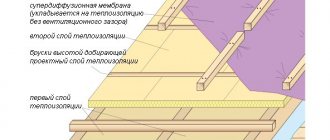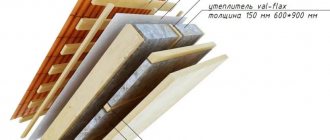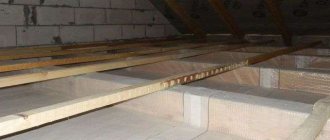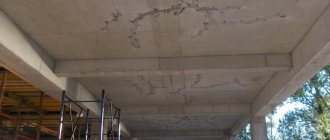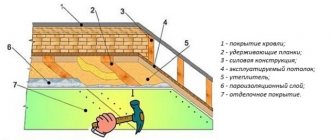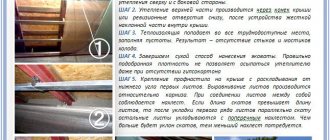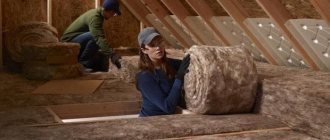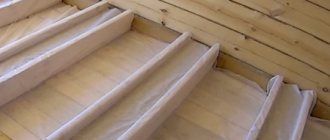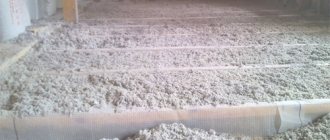Insulation of attic roof
- Roofing work in Moscow and Moscow Region
- Varieties and differences
- Roofing work in winter
- Major repairs of soft roofing
- Current roof repairs
- Urgent roof repair
- Soft roof repair
- Apartment building
- Urgent roof repair
- Seam roof repair
- Roof repair with liquid rubber
- Metal roof repair
- Copper roof repair
- Galvanized roof repair
- Repairing roof leaks
- Minor roof repairs
- Roof repair of a private house
- Cottage roof repair
- Glass roof repair
- Pitched roof repair
- Sandwich panel roof repair
- Shop roof repair
- Replacing the roof of a house
- Garage roof repair
- Repairing roof leaks in an apartment building
- Repair of the facade of a panel house
- Finishing the facade of a private house
- Removing icicles from the roof
An attic helps create additional living space through a relatively small investment and time investment. Insulation of the attic roof allows you to use the room under the roof even in the cold season, the main problem faced by private owners and owners of commercial real estate who have turned the attic space into an exploitable one is improperly performed insulation, as a result of constant leaks in the spring.
Today, there are two main types of attic roof insulation - insulation from the inside and outside. Let's figure out what the fundamental difference between these two methods is, what materials are more appropriate to use when it comes to a private home or a commercial building.
If the attic roof is already covered, it is more advisable to insulate it from the inside; the thickness of the heat-insulating material on the walls, floor and above the roof is calculated individually, based on the design features, area and climatic zone in which the building is located.
Before insulating the attic yourself, consult with a specialist which type of thermal insulation is most optimal based on your budget and design features.
Stages of roof insulation for an attic from the inside
It is recommended to cover attic spaces from the inside with mineral wool, polystyrene foam or polyurethane foam. Sometimes craftsmen in Moscow use foil materials (folgoizol, ecofol, etc.), which have good vapor barrier and noise absorption properties. The work is carried out in the following order:
- Removing the old coating.
- Laying waterproofing film.
- Laying of insulating material with its careful fixation on the base.
- Interior decoration of the attic.
Drywall, lining, PVC or MDF boards can be used as finishing materials. These coatings help achieve a smooth surface and create an attractive interior design.
What affects the cost of the service?
The total price of insulating an attic roof from the inside is set on a per 1 sq. meter. The cost of thermal insulation can be influenced by the type of insulation chosen, the material for the interior decoration of the attic space, the complexity of the design, and the volume of work performed.
Attic roof insulation with MyGuru service experts
Our service technicians will quickly insulate your attic using high-quality materials and specialized tools. Thanks to many years of experience, specialists professionally insulate the attic roof from the inside and ensure the durability of the installed thermal insulation.
By using the services of the MyGuru service in Moscow, clients can count on many advantages:
- good thermal insulation of the attic room;
- completion of work within the agreed time frame;
- guarantees for work performed.
If you still have questions about thermal insulation work and prices for insulating the attic roof of a private house, our specialists will provide more detailed advice by phone. Call, order a service on the website, we will help you insulate your attic quickly and profitably!
The price of attic insulation
When choosing a contractor for roofing work, many homeowners focus primarily on the cost of the work and the price of thermal insulation materials. Unfortunately, the high price of the work does not always indicate high quality workmanship, so when choosing a roofing company, focus on live photos from objects in the company’s portfolio, reviews on the Internet, call a specialist to the site and communicate with him live (many contractors provide this service for free) .
The cost of insulating an attic can be much cheaper, provided that all the materials are brought by the roofing company itself (but again, check individually to see if the contractor decides to cash in on your gullibility through his dealer discount from the manufacturer).
Insulating the attic from the inside in Moscow and the region
provides all types of roofing work at low prices in Moscow and the region. We insulate all types of roofs: soft, attic, private houses, commercial buildings. By choosing us as a construction contractor you get:
- Turnkey roofing work
- Purchase of all construction materials below the market price by 15%
- Quality guarantee for all work from 3 years
- Free visit of a specialist
- Prompt and free preparation of a complete work estimate
- We will bring all the building materials ourselves, and after insulating the attic, we will remove all construction waste, which will allow you to save on transportation costs.
Do not put off such a necessary heat preservation measure as installing thermal insulation, call now and within 2 hours we will arrive at the site for a free consultation.
What else can affect the cost of facade insulation in Moscow?
In addition to the main cost of insulation (labor + materials), there are other cost items. For example, indirect costs, which are also included in the estimate, include the following items:
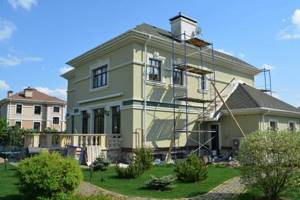
- Remoteness of the object.
They affect transportation costs (delivery of all necessary materials, transportation of scaffolding, relocation of household premises). - Availability of scaffolding at the site.
If the scaffolding is provided by the Customer himself, then the costs are reduced by the cost of renting the scaffolding itself and their transportation. - Possibility of placing workers
on site. - Various finishing options.
The presence of decorative elements and facing materials on the facade play a very important role. Additional finishing materials give the facade a unique style. - Weather.
This applies only to the winter season, when the average temperature should not be below +5C. If the priority is the timing of the work on façade insulation, then in these situations additional measures are applied related to the installation of a thermal circuit throughout the façade building to maintain the required temperature.
What is the difference between an attic and an attic?
Firstly, not every attic converted into a living space can be called an attic; a prerequisite for comfortable living is the slope of the roof and its height (it must be at least 2.5 m), do not forget about the ventilation system, which many roofers simply neglect, secondly, the air temperature and humidity should be comfortable for living.
When choosing thermal insulation for the roof of a house, there are several factors to consider:
- Further heat loss in the room is determined largely by the type of material used in construction.
- Type and location of utilities.
- House roof shape
Often the cause of condensation in the attic room is a strong difference in temperature inside and outside the house, which results in damage to the rafter system and premature wear of finishing materials. To prevent this from happening, carefully consider the choice of vapor, hydro and thermal insulation coatings.
Work technology
Violation of the operating technology can lead to freezing of the roof, the formation of abundant condensation, leaks, the formation of mold and mildew. To prevent this from happening, strictly follow the technology for installing attic insulation from the inside.
Installation of waterproofing on the roof
If the waterproofing has already been installed, this step can be skipped; otherwise, the waterproofing is laid along the rafters from the bottom to the ridge of the roof.
Laying insulation
One of the most important stages is the insulation of the walls and ceiling of the attic, guided by the characteristics of your climatic region, the type of roof, the thermal conductivity coefficient of the material, select the optimal number of layers of insulation; when installing the mineral wool slabs, overlap them, this method helps prevent possible heat loss at the joints of the mineral wool slabs.
It is not advisable to insulate the attic with polystyrene foam, since this material is highly flammable; this type of insulation is better suited for a flat roof or facade walls.
Laying a vapor barrier membrane film
The membrane plays a very important role in the roofing pie; it prevents moisture from penetrating into the insulation layer, the membrane panels are overlapped, and the joints are sealed with roofing tape.
Insulating the attic from the inside
A significant advantage of insulating the attic from the inside , that is, the “top-down” method, is the possibility of transferring the insulation of the attic roof to a later date. With lengthy construction and limited funding, this is important. The second advantage of the method of insulating the attic from the inside is the time it takes to complete the work. In this case, the insulation process no longer depends on weather conditions; it can be performed at any time of the year, since the roof is already standing and fulfilling its intended purpose.
Disadvantages of insulating the attic from the inside : high labor intensity of work, the need to use additional intermediate means to support insulation. Before installing the supporting sheathing, it must not be allowed that the insulation lies only on the vapor barrier, since with its weight it pulls the vapor barrier down, thereby damaging the vapor barrier film at the places of its fastening, and the insulation boards themselves begin to shift relative to each other, creating conditions not intended by the insulation technology gaps of different sizes and depths. But the biggest drawback is the lack of the possibility of high-quality gluing of the joints of vapor barrier panels, because good gluing requires good pressure, and it cannot be created by pressing on soft insulation. Also, at the time of gluing the joints of the vapor barrier, it is possible for the insulation to rise to its full thickness, followed by its uneven settlement and jumping out of the installation location and, as a result, creating a breakdown of heat and possible blocking of the ventilation gap. And most importantly, it will be impossible to visually control the integrity of the insulation contour - everything is already covered with a vapor barrier.
